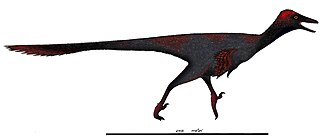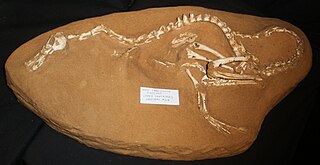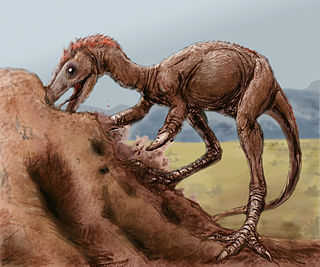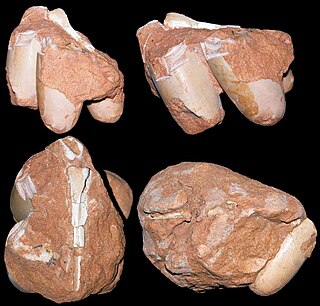 W
WAepyornithomimus is a genus of ornithomimid theropod dinosaur from the Late Cretaceous Djadokhta Formation in Mongolia. It lived in the Campanian, around 80 million years ago, when the area is thought to have been a desert. The type and only species is A. tugrikinensis.
 W
WAlmas is a genus of troodontid theropod dinosaur from the Late Cretaceous of Mongolia. It contains a single species, Almas ukhaa, named in 2017 by Pei Rui and colleagues, based on a partial articulated skeleton. The only known specimen was found in the Djadochta Formation, which is late Campanian in age.
 W
WByronosaurus is a genus of troodontid dinosaur from the Late Cretaceous Period of Mongolia.
 W
WCitipati is a genus of oviraptorid dinosaur that lived in Asia during the Late Cretaceous period, about 75 million to 71 million years ago. It is mainly known from the Ukhaa Tolgod locality at the Djadokhta Formation, where the first remains were collected during the 1990s. The genus and type species Citipati osmolskae were named and described in 2001. A second species from the adyacent Zamyn Khondt locality may also exist. Citipati is one of the best-known oviraptorids thanks to a number of well-preserved specimens, including individuals found in brooding positions atop nests of eggs, though most of them were initially referred to the related Oviraptor. These nesting specimens have helped to solidify the link between non-avian dinosaurs and birds.
 W
WDeltatheridium is an extinct species of metatherian. It lived in what is now Mongolia during the Upper Cretaceous, circa 80 million years ago. It was a basal metatherian, which places it near to the start of the lineage that led to the marsupials, such as kangaroos, wallabies, koalas, and opossums.
 W
WEstesia is an extinct genus of Late Cretaceous anguimorph lizard found in the Gobi Desert in Mongolia. It was discovered in June 1990 by a joint expedition made up of Mongolian and American palaeontologists, and described in 1992 by Mark Norell, Malcolm McKenna and Michael Novacek. This animal is of interest to palaeontologists, not only because it is close to the lineage of modern Gila monsters (Heloderma), but also because its dentition shows evidence that it was venomous.
 W
WGobioolithus is an oogenus of fossil bird egg native to Mongolia. They are small, smooth-shelled, and elongated eggs that were first discovered in the 1960s and early 70s during a series of fossil-hunting expeditions in the Gobi desert. Two oospecies have been described: Gobioolithus minor and G. major. The eggs were probably laid in colonial nesting sites on the banks of rivers and lakes.
 W
WGobiosuchus was a gobiosuchid crocodyliform described in 1972 by Polish palaeontologist Halszka Osmólska. It hails from the Late Cretaceous of Bayn Dzak, in the Gobi Desert of Mongolia.
 W
WGobivenator is an extinct genus of troodontid theropod dinosaur known from the late Campanian Djadokhta Formation of central Gobi Desert, Mongolia. It contains a single species, Gobivenator mongoliensis. G. mongoliensis is known from a single individual, which represents the most complete specimen of a Late Cretaceous troodontid currently known.
 W
WHalszkaraptor is a genus of waterfowl-like dromaeosaurid dinosaurs from Mongolia that lived during the Late Cretaceous period. It contains only one known species, Halszkaraptor escuilliei.
 W
WKhaan was an oviraptorid dinosaur that was found in the Djadochta Formation of Mongolia and lived in the Late Cretaceous Period (Campanian), 75-71 million years ago.
 W
WKol is an extinct genus of alvarezsaurid theropod dinosaur from the Late Cretaceous of Mongolia. The type and only species is Kol ghuva. The type specimen was excavated from the Ukhaa Tolgod locality of the Djadochta Formation, dating to about 75 million years ago. It is believed to have been about twice the size of the contemporary Shuvuuia. However, unlike Shuvuuia, which is known from many well preserved specimens, and although Ukhaa Tolgod has been thoroughly explored, Kol is known only from one complete foot, suggesting that it must have been relatively rare in that ecosystem.
 W
WKryptobaatarand also known as Gobibaatar or Tugrigbaatar is an extinct mammalian genus dating from the Upper Cretaceous Period and identified in Central Asia. This animal was a member of the extinct order of Multituberculata within the suborder Cimolodonta, and was a member of the family Djadochtatheriidae. It lived contemporaneously with some of the dinosaurs. Its skull had a length of perhaps 3 cm.
 W
WMahakala is a genus of halszkaraptorine theropod dinosaur from the Campanian-age Upper Cretaceous Djadokhta Formation of Ömnögovi, Mongolia. It is based on a partial skeleton found in the Gobi Desert. Mahakala was a small dromaeosaurid, and its skeleton shows features that are also found in early troodontids and avialans. Despite its late appearance, it is among the most basal dromaeosaurids. Its small size, and the small size of other basal deinonychosaurians, suggests that small size appeared before flight capability in birds.
 W
WOviraptor is a genus of oviraptorid dinosaur that lived in Asia during the Late Cretaceous period. The first remains were collected from the Djadokhta Formation of Mongolia in 1923 during a paleontological expedition led by Roy Chapman Andrews, and in the following year the genus and type species Oviraptor philoceratops were named by Henry Fairfield Osborn. The genus name refers to the initial thought of egg-stealing habits, and the specific name was intended to reinforce this view indicating a preference over ceratopsian eggs. Despite the fact that numerous specimens have been referred to the genus, Oviraptor is only known from a single partial skeleton regarded as the holotype, as well as a nest of about fifteen eggs and several small fragments from a juvenile.
 W
WPinacosaurus is a genus of ankylosaurid thyreophoran dinosaur that lived in Asia during the Late Cretaceous, mainly in Mongolia and China.
 W
WProtoceratops is a genus of sheep-sized herbivorous ceratopsian dinosaur, from the Upper Cretaceous Period of what is now Mongolia. It was a member of the Protoceratopsidae, a group of early horned dinosaurs. Unlike later ceratopsians, however, it was a much smaller creature that lacked well-developed horns and retained some basal traits not seen in later genera.
 W
WSaurornithoides is a genus of troodontid maniraptoran dinosaur, which lived during the Late Cretaceous period. These creatures were predators, which could run fast on their hind legs and had excellent sight and hearing. The name is derived from the Greek stems saur~ (lizard), ornith~ (bird) and eides (form), referring to its bird-like skull.
 W
WShuvuuia is a genus of bird-like theropod dinosaur from the late Cretaceous period of Mongolia. It is a member of the family Alvarezsauridae, small coelurosaurian dinosaurs which are characterized by short but powerful forelimbs specialized for digging. The type species is Shuvuuia deserti, or "desert bird". The name Shuvuuia is derived from the Mongolian word shuvuu (шувуу) meaning "bird".
 W
WStyloolithus is an oogenus of highly distinctive fossil egg from the Upper Cretaceous Djadokhta Formation and the Barun Goyot Formation in Mongolia.
 W
WTsaagan is a genus of dromaeosaurid dinosaur from the Djadokhta Formation of the Late Cretaceous of Mongolia.
 W
WUdanoceratops is a genus of large leptoceratopsid dinosaur that lived during the Late Cretaceous period of Mongolia, in what is now the Djadokhta Formation.
 W
WVelociraptor is a genus of dromaeosaurid theropod dinosaur that lived approximately 75 to 71 million years ago during the latter part of the Cretaceous Period. Two species are currently recognized, although others have been assigned in the past. The type species is V. mongoliensis; fossils of this species have been discovered in Mongolia. A second species, V. osmolskae, was named in 2008 for skull material from Inner Mongolia, China.
 W
WZalambdalestes was a eutherian mammal, most likely not a placental due to the presence of an epipubic bone, living during the Upper Cretaceous in Mongolia.
 W
WZalambdalestidae is a clade of Asian eutherians occurring during the Late Cretaceous. Once classified as Glires, features like epipubic bones and various cranial elements have identified these animals as outside of Placentalia, representing thus a specialised clade of non-placental eutherians without any living descendants, and potentially rather different from modern placentals in at least reproductive anatomy.